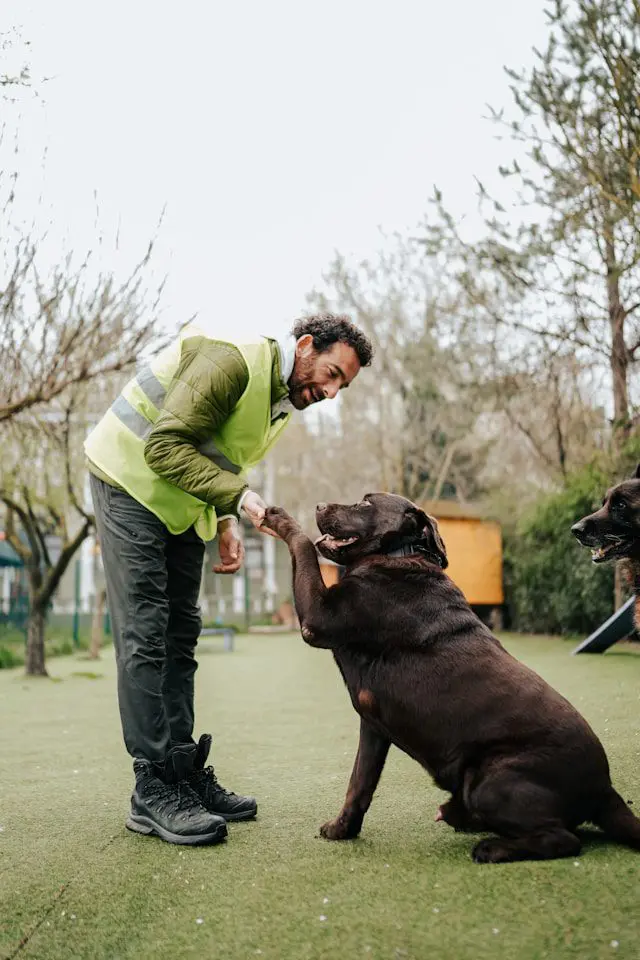Emotional support dogs have become increasingly recognized for their mental health benefits, offering unique companionship for individuals struggling with mental and emotional challenges. If you’re wondering how to get an emotional support dog, you’ve come to the right place. This comprehensive guide will walk you through the entire process, covering everything from understanding what these animals are to the legal considerations, selection process, and day-to-day care.

Table of Contents
- Understanding Emotional Support Dogs
- Legal Status of Emotional Support Dogs
- How to Get an Emotional Support Dog: Qualifying and Certification
- Choosing the Right Dog
- Acquiring Your Emotional Support Dog
- Preparing Your Home
- Training Your Emotional Support Dog
- Living with Your Emotional Support Dog
- Conclusion: Get Your Emotional Support Dog Today
Understanding Emotional Support Dogs
An emotional support dog (ESD) is an animal prescribed by a licensed mental health professional to provide comfort and support to an individual with a diagnosed mental or emotional disability. The key distinction is the prescription – this official designation sets ESDs apart from regular pets and grants them certain legal protections.
It’s important to distinguish emotional support dogs from other types of assistance animals:
- Service dogs: Trained to perform specific tasks for individuals with disabilities
- Therapy dogs: Provide comfort in various settings but work with multiple people
- Emotional support dogs: Offer support through companionship without specific task training
Benefits of Having an Emotional Support Dog
Emotional support dogs can provide numerous psychological and emotional benefits. Here’s how they can improve your life:
- Reduce anxiety levels
- Manage depression by providing structure and purpose
- Offer a sense of security for individuals with PTSD
- Aid in emotional regulation
- Improve sleep quality for those struggling with anxiety or depression
- Increase social interaction
- Enhance physical health through increased daily exercise
Beyond mental health benefits, owning an emotional support dog can lead to broader improvements in social interaction and physical health. Dogs often encourage their owners to engage more with others, naturally increasing daily exercise. Caring for an ESD provides a sense of routine to one’s day, and the physical affection from a dog can be comforting and healing. See more about the advantages of owning pets.

Legal Status of Emotional Support Dogs
Understanding the legal landscape is crucial when learning how to get an emotional support dog. The primary federal laws pertaining to ESDs are:
- Fair Housing Act (FHA):
- Allows individuals with a documented need for an emotional support animal to have reasonable accommodation in housing
- This applies even if the property has a “no pets” policy
- Landlords cannot charge extra fees or deposits for ESDs
- Air Carrier Access Act (ACAA):
- As of 2021, airlines are no longer required to accommodate emotional support animals in the cabin free of charge
- Many airlines now treat ESDs as pets, which may involve additional fees and restrictions
- It’s crucial to check with individual airlines well in advance of travel, as policies can vary and change over time.
How to Get an Emotional Support Dog: Qualifying and Certification
To get an emotional support dog, you’ll need to be diagnosed with a qualifying mental health condition. Common conditions include:
- Major Depressive Disorder
- Generalized Anxiety Disorder
- Post-Traumatic Stress Disorder (PTSD)
- Bipolar Disorder
- Obsessive-Compulsive Disorder (OCD)
The process of getting an emotional support dog involves several steps:
- Recognize symptoms that are interfering with your daily life and well-being
- Schedule an appointment with a licensed mental health professional
- Undergo a thorough evaluation
- Receive a diagnosis if your symptoms meet the criteria for a mental health condition
- Discuss treatment options, including the potential benefit of an emotional support dog

Only a licensed mental health professional can provide the documentation necessary to legally designate an animal as an emotional support dog. They can also integrate the ESD recommendation into a comprehensive treatment plan.
To “certify” your dog as an emotional support animal, obtain a prescription letter from your mental health professional. This letter should be updated annually. Be aware that online services offering “official” registration or certification for emotional support dogs are not legitimate. The only document that matters is the letter from your mental health professional.
Choosing the Right Dog
When learning how to get an emotional support dog, selecting the right canine companion is crucial. Consider the following factors:
- Temperament: Should align with your emotional needs
- Size: Important especially if you live in a small apartment or have limited mobility
- Energy level: Should match your lifestyle and ability to provide exercise
- Age: Puppies require more time and energy for training; adult dogs might offer more immediate support
While any breed can potentially serve as an emotional support dog, some breeds are often recommended due to their temperament and characteristics:
- Labrador Retrievers: Friendly, outgoing nature
- Golden Retrievers: Eager to please, gentle
- Poodles: Intelligent and highly trainable
- Cavalier King Charles Spaniels: Affectionate and gentle, excellent lap dogs

Acquiring Your Emotional Support Dog
When figuring out how to get an emotional support dog, you’ll need to decide whether to adopt or buy from a breeder:
Adoption:
- More cost-effective
- Gives a home to a dog in need
- Often have adult dogs available (calmer, less training required)
Buying from a reputable breeder:
- More predictability in terms of size, temperament, and potential health issues
- Often provide health guarantees for puppies
- Start early socialization and basic training
Tips for choosing your ESD:
- Observe how the dog interacts with shelter staff and other animals
- Consider the dog’s energy level and how it responds to you
- Ask about the dog’s background and any known health issues
- Spend time with the dog before deciding
Preparing Your Home
Once you’ve chosen your emotional support dog, it’s time to prepare your home:
- Create a safe, comfortable space for your new companion:
- Set up a bed, water bowl, and some toys. We like simple water bowls with smaller footprints, because there is less water than can get trapped underneath the bowl and cause bad odors.
- Remove or secure potentially dangerous items (toxic plants, small objects, electrical cords). This includes snacks and food your dog could get into.
- Stock up on essentials:
- Food and treats. Our vet recommends IAMS, Purina Pro, Hill’s Science Diet, and Royal Canin.
- Collar and leash. If you get a bigger dog, do yourself a favor and buy a retractable leash. Many dogs tug when they sniff or see something interesting. Give them an extra few feet to maneuver around. This requires a lot less effort, and you might be surprised how often your dog stays close to your side. We like retractable leashes with with waste bag holders.
- Grooming supplies. If you don’t have a dog brush yet, skip the metal and wire brushes that may irritate your dog’s skin and get a silicone brush instead. They work just as well and pair excellently with water to remove loose hair when giving your dog a bath. They also have a side benefit of massaging your dog:
- Establish a routine:
- Set consistent feeding times
- Plan regular walks and play sessions
Consistency can help your new dog adjust more quickly to their new home and role as an emotional support animal.

Training Your Emotional Support Dog
While emotional support dogs don’t require specialized task training like service dogs, basic obedience training is essential. This ensures your dog is well-behaved and can provide effective support.
Basic training should include:
- House training: A benefit of adopting an older dog is that you usually get to skip this.
- Basic commands: “sit,” “stay,” “come,” and “leave it”
- Leash training for stress-free outings (or use a retractable leash and make it easier)
Some owners choose to train their emotional support dogs in specific techniques that can provide additional support. For example, deep pressure therapy involves training your dog to apply gentle pressure by lying across your lap or chest, which can be calming during anxiety attacks.
Living with Your Emotional Support Dog
Daily Care
Proper daily care is essential for ensuring your emotional support dog remains healthy and capable of providing the support you need:
- Provide a balanced diet
- Ensure regular exercise
- Maintain grooming routines
- Schedule regular veterinary check-ups.
- Stay up to date on vaccinations and preventative care. This also is helpful in case you need to board your dog, as they will require most of the standard vaccinations.
While emotional support dogs don’t have the same public access rights as service dogs, you may still encounter situations where you need to navigate public spaces with your ESD. Know your rights and be prepared to calmly explain the role of your emotional support dog if questioned.
Traveling
Traveling with an emotional support dog requires careful planning:
- Always check the latest policies of airlines, hotels, and other travel services regarding emotional support animals
- Carry your mental health professional’s letter and any required health certificates for your dog, or store images of them on your phone.
- If you are traveling with your pet, see our guide to vet care while traveling.
FAQs
How much does it cost to get an emotional support dog?
Costs vary depending on whether you adopt or purchase from a breeder. Adoption fees typically range from $50 to $500, while purebred dogs from breeders can cost $500 to $3000 or more. Don’t forget to factor in ongoing costs for food, veterinary care, and supplies.
Can my current pet become an emotional support dog?
Yes, if a mental health professional determines it would be beneficial and provides the necessary documentation. The animal’s temperament and your bond with it are more important than its breed or origin.
Do emotional support dogs need special training?
While not legally required, basic obedience training is highly recommended for ESDs to ensure they can behave appropriately in various situations and provide effective support.
How is an emotional support dog different from a service dog?
Service dogs are trained to perform specific tasks for individuals with disabilities and have broader public access rights. Emotional support dogs provide comfort through companionship and have more limited legal protections, primarily in housing.
Can landlords refuse to allow my emotional support dog?
Under the Fair Housing Act, landlords must provide reasonable accommodations for emotional support animals, even in buildings with “no pets” policies. However, they can request documentation from a mental health professional.
Does my emotional support dog need to wear a special vest or harness for identification?
No, an emotional support animal (ESA) is not legally required to wear a vest. However, many owners choose to use vests, harnesses, or ID tags to help identify their dog as an ESA. This can help mitigate misunderstandings and make it easier to explain the animal’s role in public places. While not a legal requirement, a vest can be a helpful tool in promoting understanding and reducing potential conflicts.

Takeaway: Get Your Emotional Support Dog Today
Learning how to get an emotional support dog involves understanding the legal landscape, working with a mental health professional, carefully selecting and training your dog, and maintaining ongoing care and documentation. While the process requires effort, the benefits of having an emotional support dog can be life-changing for individuals struggling with mental health challenges.
Remember that an emotional support dog is just one component of a comprehensive mental health treatment plan. Continue working closely with your mental health professional to ensure the best outcomes for your well-being.
Have you considered getting an emotional support dog? Share your thoughts or experiences in the comments below and subscribe to the Gorilla Gazette newsletter for more tips delivered directly to your inbox!
Next, read on about essential dog camping supplies for the gear your emotional support dog will need on your next outdoor adventure together.


Leave a Reply